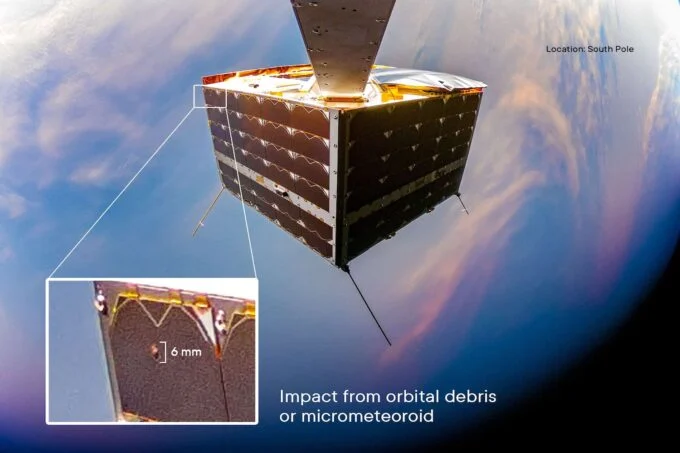A satellite image reveals the destruction resulting from an unidentified impact
The small satellite withstood an impact that was likely the result of either a micrometeorite or a fragment of space debris.

The Earth's orbit is becoming increasingly congested, with numerous new satellites being deployed and remnants of inactive ones drifting in space. A recent image captured by a satellite has unveiled unexpected damage to its solar panel, likely resulting from an unidentified impact that occurred within the past year.
This week, NanoAvionics, a satellite company, announced that its MP42 microsatellite bus endured a collision in low Earth orbit, which resulted in a 0.2-inch (6 millimeters) hole in one of its solar arrays. The company identified the damage through the satellite's imaging capabilities, as the chickpea-sized crater was visible in a photograph taken by the onboard camera this month. However, NanoAvionics remains uncertain about the nature of the object that struck its satellite. "While we cannot dismiss the possibility of an alien satellite-pecker, we believe it is more likely to be a fragment of space debris or a micrometeoroid," the company stated on X.
Determining the exact timing of the impact is also challenging. The last selfie taken by MP42 was in April 2023, meaning the collision could have occurred at any point over the past eighteen months.
Despite the damage to its solar panel, the satellite continues to operate effectively. Telemetry data indicates that the impact has not compromised the satellite's power generation capabilities, complicating efforts to ascertain when the incident occurred.
"Regardless of whether the impact was caused by a micrometeoroid or a piece of space debris, this collision underscores the necessity for responsible operations in space and prompts us to consider the resilience of satellites against such occurrences," NanoAvionics remarked in a statement.
Currently, the Department of Defense's global Space Surveillance Network is tracking over 27,000 pieces of orbital debris, with many smaller fragments remaining undetected. The presence of this space debris poses a risk to other satellites in orbit, and the situation is expected to deteriorate as space becomes increasingly populated.
Earlier this month, a communications satellite disintegrated in space, resulting in a cloud of debris that expanded to nearly 500 fragments of spacecraft components drifting uncontrollably in orbit. Between 1999 and 2022, the International Space Station has conducted 32 maneuvers to avoid collisions with pieces of space debris.
MP42 was launched in April 2022 as part of the SpaceX Transporter-4 mission, serving as a demonstration for NanoAvionics’ M6P cubesat platform intended for various space applications. According to NanoAvionics, the company’s satellites are equipped with propulsion systems that facilitate controlled deorbiting, thereby mitigating long-term debris accumulation in space. It is advisable for other companies to adopt similar practices to promote a cleaner orbital environment and reduce the likelihood of collisions.